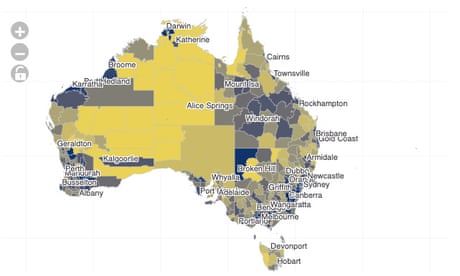- by foxnews
- 08 Apr 2025
Australia’s most advantaged and disadvantaged areas: how does your suburb compare?
Australia’s most advantaged and disadvantaged areas: how does your suburb compare?
- by theguardian
- 28 Apr 2023
- in news

Australia's most advantaged suburbs tend to be on or next to water and are clustered around Sydney's eastern suburbs and north shore, while regional areas dominate the list of the nation's most disadvantaged areas, new government data reveals.
Updated socioeconomic indexes based on 2021 census data released by the Australian Bureau of Statistics on Thursday reveal that Woollahra in Sydney's inner-east is the nation's most advantaged local government area (LGA), and six of the top 10 most advantaged LGAs suburbs are in close proximity of Sydney's CBD.
The top 10 most advantaged LGAs in order are: Woollahra (NSW), Mosman (NSW), Ku-ring-gai (NSW), Darwin Waterfront Precinct (NT), North Sydney (NSW), Waverley (NSW), Lane Cove (NSW), Peppermint Grove (WA), Nedlands (WA) and Cottesloe (WA).
"Nine of the 10 most advantaged LGAs are on waterfronts or close to water, including Sydney Harbour, the Darwin waterfront, and the Swan River in Perth," the ABS said.
On the other end of the spectrum, Woorabinda, which is 170km south-west of Rockhampton in central Queensland is the most disadvantaged LGA, with the 10 most disadvantaged areas spread across Queensland and the Northern Territory.
The 10 most disadvantaged LGAs in order are: Woorabinda (Queensland), Cherbourg (Qld), Belyuen (NT), West Daly (NT), Yarrabah (Qld), Kowanyama (Qld), Wujal Wujal (Qld), East Arnhem (NT), Doomadgee (Qld) and Central Desert (NT).
The socioeconomic index takes into account census data on income, education, occupation, housing, employment and family structure, among other factors, to rank an area's advantage and disadvantage.
The factors are combined to create a score with an average of about 1,000. Lower scores indicate areas of relative disadvantage.
You can search the rankings and scores for all LGAs in the table below:
In a broad trend, the ABS noted that "disadvantaged areas tend to be in regional and remote communities, while advantaged areas tend to be in major cities". This in part reflects that city-based jobs, including those of office workers, commonly require a university degree, while agriculture and resource jobs are traditionally located in regional areas.
However the ABS data revealed how discrepancies can emerge between neighbouring LGAs. "Noosa and Gympie in Queensland are an interesting example of this rank applied in practice," the ABS said. "Noosa ranked in the highest 20% of LGAs, while neighbouring Gympie ranked in the lowest 15%. This shows that socioeconomic factors can be very different across areas, even if they're close together."
Boroondara in Melbourne's eastern suburbs was ranked as Victoria's most advantaged LGA, helped in large part by its residents' high education levels - 52% have a university degree compared with the state average of 29% and national average of 26%.
Walkerville was South Australia's second-highest-ranking LGA for advantage. It recorded 20% of the population working more than 45 hours a week, compared with a state average of 17% and an Australian average of 18%.
- by foxnews
- descember 09, 2016
Ancient settlement reveals remains of 1,800-year-old dog, baffling experts: 'Preserved quite well'
Archaeologists have recently unearthed the remarkably well-preserved remains of a dog from ancient Rome, shedding light on the widespread practice of ritual sacrifice in antiquity.
read more


